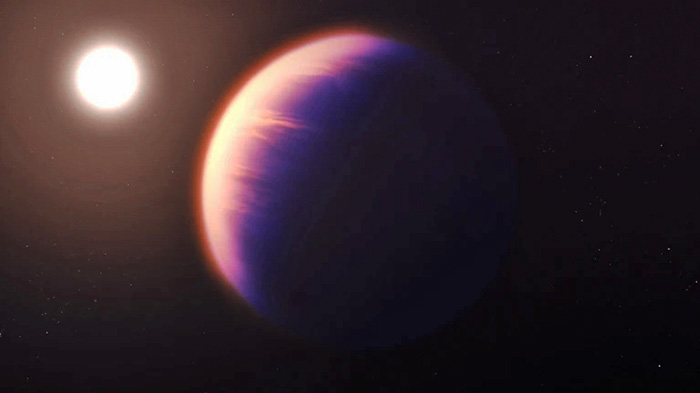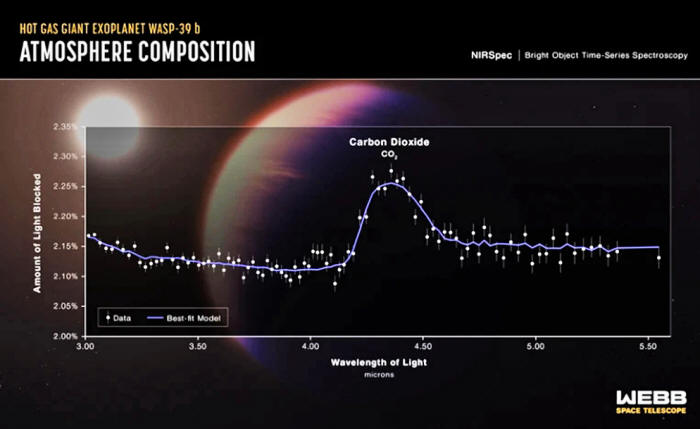|

by Shannon Hall
August 29,
2022
from
Nature Website

An artists impression of the exoplanet WASP-39 b,
a gassy
giant orbiting close to its sun
WASP-39b orbits close to its star,
making
it a hot exoplanet (artist's rendering).
Credit:
NASA, ESA, CSA, Joseph Olmsted (STScI)
Report heralds
what's to come
from the
landmark observatory,
which is set to
explore
76 worlds during
its first year.
The James Webb
Space Telescope - already famous for its
mesmerizing images of the cosmos -
has done it again.
The telescope
has captured the first unambiguous evidence of carbon dioxide
(CO2) in the atmosphere of a planet outside the Solar
System.
The finding not
only provides tantalizing hints about how
the
exoplanet formed, but is also a harbinger for what's to
come as Webb studies more and more alien worlds.
It was reported in
a manuscript posted on the preprint server arXiv, 1 ahead
of peer review, and is expected to be published in Nature in
the coming days. (Nature's news team is independent of its
journals team.)
The discovery is
presented in a data plot with none of the lustre of Webb's previous
images - which showed
galaxies locked in a cosmic dance and radiant
clouds in a stellar nursery.
But Jessie
Christiansen, an astronomer at the NASA Exoplanet Science
Institute at the California Institute of Technology in Pasadena,
describes the data as "gorgeous".
The plot, or
spectrum, reveals detailed information about the atmosphere of the
exoplanet
WASP-39b, called a hot Jupiter
by scientists because it has a diameter similar to Jupiter's but
orbits its star much more closely than Mercury orbits the Sun,
making it incredibly hot.
The planet, which
is more than 200
parsecs from Earth, was initially
discovered during ground-based observations 2 and later
detected by NASA's Spitzer Space Telescope, which operated
between 2003 and 2020.
Data from the
latter suggested 3 that WASP-39b's atmosphere might
contain carbon dioxide, but they were inconclusive.

Researchers detected carbon dioxide CO2
in
WASP-39b's atmosphere
when
the exoplanet crossed in front of its star.
The
data plot shows a telltale blip where
infrared wavelengths from the star's light
were
absorbed by carbon dioxide
on the
exoplanet.
Credit:
NASA, ESA, CSA, Leah Hustak (STScI),
Joseph
Olmsted (STScI)
Then came Webb...
For a little more
than eight hours on 10 July, the infrared telescope observed the
planet moving across the face of its star. In this time, starlight
shone through the planet's atmosphere, where various molecules
absorbed specific wavelengths of infrared light.
Astronomers
wondered whether carbon dioxide would show up as a telltale blip in
the spectrum.
"And there it
was - just jumping off of the computer screen," says study
co-author Natalie Batalha, an astronomer at the
University of California, Santa Cruz (UCSC), who leads Webb's
Transiting Exoplanet Early Release Science team.
Batalha wasn't
alone.
When Christiansen,
who is not part of the team, saw the data, she gasped.
"I was like,
'Oh, there it is'," she says. "We've had hints of it before, but
this is the first time it's really been a 'punch in the face'
kind of detection."
Mysterious origins
The result has
bolstered confidence that Webb is going to be revolutionary for
exoplanet research.
In its first year
of operation alone, the telescope is commissioned to observe 76
exoplanets; the final tally could be in the hundreds over its
lifetime.
It will gaze
through the atmospheres of gas giants and small, rocky worlds that
could be similar to Earth.
"My very first
thought when I saw that signal was, 'Wow, this is going to
work'," Batalha says.
But finding carbon
dioxide is also impressive on its own.
"From a science
standpoint, it's extremely exciting," says Jonathan Fortney,
director of the Other Worlds Laboratory at UCSC and a co-author
of the paper.
It would be
reasonable to expect that a planet similar to Jupiter, which formed
from the same disk of material as its star, would have roughly the
same chemical make-up as that star.
But that isn't the
case in our Solar System; nor is it true for WASP-39b.
The exoplanet's
strong
carbon dioxide (CO2)
signal suggests that it is enriched with elements heavier than the
hydrogen and helium that typically constitute stars.
The question is,
why?
"That's where
the story starts to get interesting," Batalha says.
It's possible that
when WASP-39b was young, it was bombarded with comets and asteroids,
which could have delivered heavier elements such as carbon and
oxygen.
Interestingly, the
exoplanet seems to have the same amounts of heavy elements as
Saturn, which astronomers also think endured a violent youth.
Or the answer might
be that WASP-39b formed from materials in the cold outer reaches of
its planetary system, then migrated inwards.
At its final
resting spot, it snuggled up to its host star, which could have
blasted away some of the hydrogen in the exoplanet's atmosphere -
causing the heavier elements to become more concentrated, and making
it richer in carbon dioxide than it was originally.
Fortney, Batalha
and their colleagues are working on four papers that will analyze
the planet's spectrum in significantly more detail, and probe these
possibilities.
"It's like
archaeology," Batalha says.
"You're trying
to build up a big story - and you're using the molecules
themselves as tracers of that story."
The building blocks of
life
Spotting carbon
dioxide in a planet's atmosphere is a stepping stone towards
detecting 'life' (like Earth's one) beyond Earth.
Astronomers don't
expect WASP-39b to be capable of hosting life - it is much too close
to its star. They don't even expect the Webb telescope to find
definitive signs of life on another planet.
But using Webb to
detect carbon dioxide helps to lay the foundation for future
discoveries.
Astronomers
think that a mixture of carbon dioxide and methane in a planet's
atmosphere could be an indicator of life - what's known as a
biosignature.
WASP-39b's
signal is "halfway to a good biosignature", says
Christiansen.
Batalha's team
has built a model predicting that the planet's atmosphere also
contains water, carbon monoxide and hydrogen sulfide - but
little methane.
Ultimately, the
detection of life will probably require an observatory even more
advanced than Webb.
But, Batalha
says,
"this is a
really important phase that we need to pass through to be
ready for that technology in the future".
|



